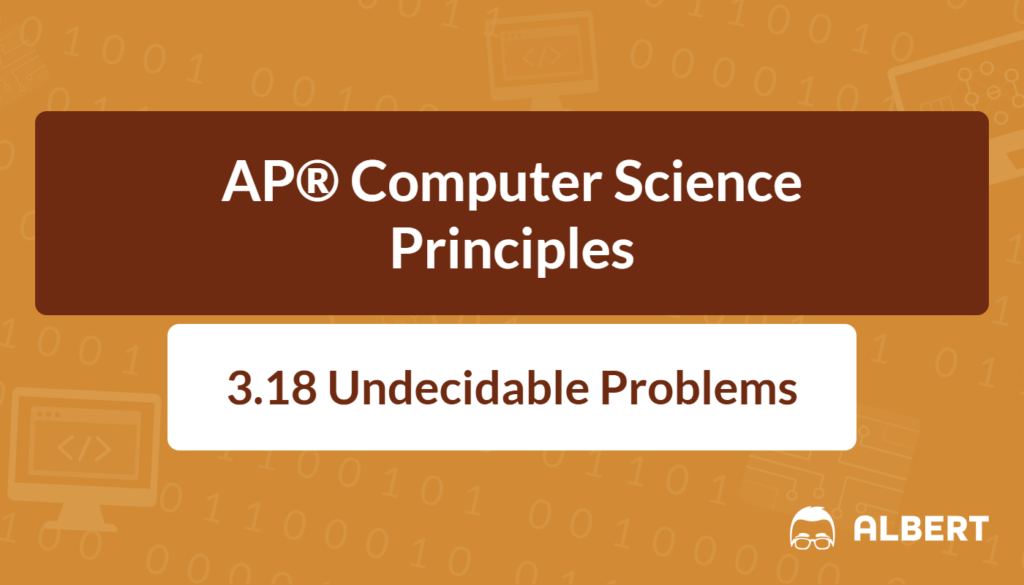Undecidable problems may seem puzzling at first, yet they hold immense importance in computer science. These types of problems cannot be fully solved by any single algorithm, no matter how clever one may get. Therefore, studying them reveals the boundaries of what computers can and cannot do. This article explores the basic definitions, examples, and implications of both decidable and undecidable problems.
By the end, it becomes clearer that some questions do not have a one-size-fits-all solution. In the process, understanding why these issues arise also deepens appreciation for the power and limitations of algorithms. As a result, AP® CSP students gain a stronger grounding in topics that shape modern digital technology.
What We Review
What Are Decidable Problems?
Decidable problems are those for which an algorithm can be written that provides a correct yes-or-no response for every possible input. In other words, a programmmer can confidently state that the procedure will always work. Therefore, whenever such a problem is run through this algorithm, an answer emerges without fail.
Example: Checking if a Number Is Even
Consider a program that determines if a number is even.
Sample code snippet:
number ← 12
IF(number MOD 2 == 0)
{
DISPLAY("Even")
}
ELSE
{
DISPLAY("Odd")
}- Line 1: Declares an integer (12) named number.
- Line 2: Uses the modulus operator (MOD) to check if number has a remainder when divided by 2.
- Line 4: If number has no remainder (0), it prints “Even.”
- Line 7: Otherwise, it prints “Odd.”
This problem is decidable because the steps are clear, and it can handle any integer input.
Understanding Undecidable Problems
Undecidable problems stand in stark contrast to decidable problems. While a decidable problem has a guaranteed procedure that always works, an undecidable problem lacks such a universal algorithm. Consequently, no single approach can solve every instance of the problem correctly.
One of the most famous examples is the Halting Problem. In simple terms, it asks whether a program can be analyzed to determine if it will ever terminate. Although some instances may be solvable, there is no method that works on all cases. As a result, these problems highlight where logic and computation reach their fundamental limits.
Decidable vs. Undecidable
- Decidable: An algorithm exists to solve the problem for all inputs.
- Undecidable: No algorithm can solve the problem for all possible instances.
Some scenarios of an undecidable problem might look trivial and solvable, but the problem as a whole remains impossible to settle universally.
Why Do Undecidable Problems Matter?
Undecidable problems play a key role in theoretical computer science. They help define the line between solvable and unsolvable computations. In addition, they guide researchers to see where algorithmic technique alone fails, prompting innovative ideas.
Moreover, undecidable problems influence programming language design and software testing. For instance, developers wish to create tools that detect bugs automatically. However, because of undecidability, not all bugs can be detected for every program. In real-world scenarios, teams often face trade-offs: thorough but slow checks vs. faster yet incomplete checks. Consequently, understanding these boundaries encourages more efficient approaches and realistic goals.
Example of an Undecidable Problem: The Halting Problem
Consider trying to write a program called HaltsOrNot to decide if another program ever stops running. The idea is that HaltsOrNot takes two inputs: (1) some program P, and (2) an input x. The question: “Does P stop when given x?” seems simple.
However, assume such a program exists, and then feed it a tricky set of instructions. In this tricky setup, HaltsOrNot reaches a contradiction, meaning it produces a logical inconsistency when trying to evaluate certain inputs. This contradiction proves that no algorithm can handle all possible cases of this question.
Therefore, the Halting Problem demonstrates that certain yes-or-no questions lie beyond the reach of any algorithm. As a result, it is a classic example of an undecidable problem in computer science.

Common Misconceptions and Challenges
Some might think small examples of halting can be solved, so the problem must be decidable. Indeed, certain instances are easy to predict. For example, if the program has a simple loop, one can often analyze it manually. However, the entire range of potential programs includes infinite variations, making a single universal checker impossible.
Another misunderstanding involves solutions that seem to work for many cases but fail on edge inputs. Undecidability implies that no matter how examples are analyzed, there will always be a stubborn case that breaks the algorithm. Thus, the root issue isn’t code complexity alone but the logical immensity of all possible scenarios.
Key Terms to Know
- Decidable Problems – A decision problem for which an algorithm can be written to produce a correct yes-or-no answer for all possible inputs.
- Undecidable Problems – A problem where no single algorithm can produce correct results for every possible input scenario.
- Algorithm – A step-by-step procedure designed to solve a problem or perform a task.
- Halting Problem – A classic example of an undecidable problem that concerns determining whether a program will ever stop running.
- Instances – Specific examples or sets of inputs for a problem.
- Correct Output – The accurate and expected answer to a problem instance.
Conclusion
In summary, decidable problems have a clear-cut solution process for every input, whereas undecidable problems do not. By examining examples like the even number check (decidable) and the Halting Problem (undecidable), it becomes evident that not all questions in computer science can be definitively answered by an algorithm.
Although facing such boundaries may seem daunting, this knowledge is empowering. Programmers and computer scientists recognize that certain tasks are either too complex or logically impossible to solve universally. Therefore, an appreciation for undecidable problems not only clarifies the scope of computation but also encourages innovative thinking and method design.
Sharpen Your Skills for AP® Computer Science Principles
Are you preparing for the AP® Computer Science Principles test? We’ve got you covered! Try our review articles designed to help you confidently tackle real-world AP® Computer Science Principles questions. You’ll find everything you need to succeed, from quick tips to detailed strategies. Start exploring now!
- AP® Computer Science Principles 3.15 Review
- AP® Computer Science Principles 3.16 Review
- AP® Computer Science Principles 3.17 Review
Need help preparing for your AP® Computer Science Principles exam?
Albert has hundreds of AP® Computer Science Principles practice questions and full-length practice tests to try out.








